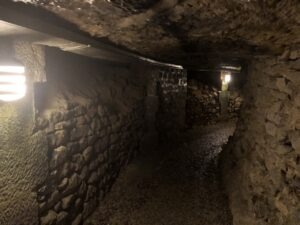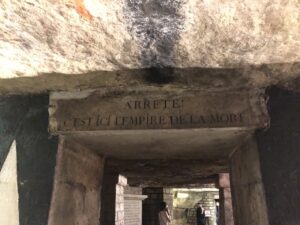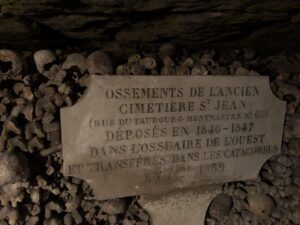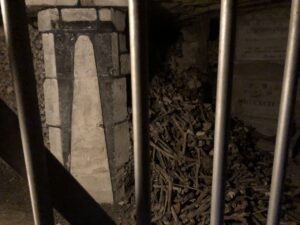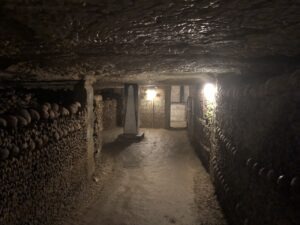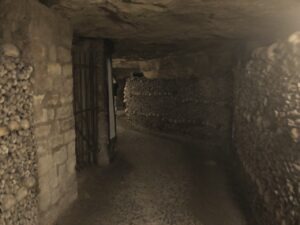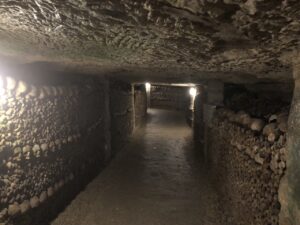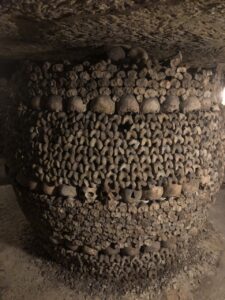Paris, quite poetically known as the City of Light, is perhaps one of the most romantic destinations in the world. Yet, deep beneath its streets lies a labyrinth that is dark, ominous, and truly macabre. I am referring to the famed Catacombs of Paris, where visitors can stroll through tunnels filled with elaborately arranged bones of the city’s long dead. While this subterranean “Empire of Death” may make some shudder, it is truly a unique and thought-provoking experience for those who wish to descend into it.
The Paris Catacombs began life as the Tombe-Issoire quarries, from which Lutetian limestone was extracted. It was the Romans that began using open pit quarries in the area. The work then shifted to underground tunnels in the 15th century. The quarries were originally outside the bounds of Paris, but the city eventually expanded and new neighborhoods were built on top of the mines. The risks of doing this became apparent in the 1770s when there was a series of massive sinkholes causing damage and death. As a result, the quarries were officially closed in 1776. However, they wouldn’t remain abandoned for long.
Aside from sinkholes, there was another crisis going on Paris. The city was running out of room for its deceased residents. During this time, most people would be buried in a local church graveyard, the largest of which was Saints-Innocents Cemetery. Unlike today, where bodies are often buried in an individual plot, the dead of 18th century Paris would be placed into communal graves. The pits in Saints-Innocents might be filled with up to 1,500 bodies each before being covered over. In order to reuse space, older burials would be dug up and the bones removed to charnel houses on the cemetery grounds.
With the expanding population of Paris, the situation became untenable. Due to overuse, the ground of Saints-Innocents Cemetery was 2 meters higher than street level. There’s one account of a neighboring cellar wall bursting due to pressure from all the bodies. The stench of decay was wafting into the surrounding neighborhood. The cemetery bordered a large market, and the citizens were worried about contamination and illness.
It became clear that Paris needed to find a new resting place for its deceased. The huge network of abandoned mines beneath the streets provided a solution. In 1780, the Saints-Innocents Cemetery was closed to new burials. In 1786, the quarries were consecrated as the Paris Municipal Ossuary, with the first remains having been moved there in late 1785.
It took 15 months to empty out the Saints-Innocents Cemetery. Every night, there was a grim procession transporting remains to the catacombs. Such work was not done during the day, to avoid upsetting the citizenry. The project then shifted to other cemeteries and burial sites around Paris. The effort would last until 1814, though it would revive later that century, with the last bones added in 1860. The remains of over 6 million people now rest there.
When touring the catacombs today, visitors will see bones elaborately stacked and arranged, multiple feet thick, on either side of the main path. However, it was not always this way. When the very first tour was given in 1809, the bones were mainly in unorganized piles. Then, from 1810 to 1814, they were artistically arranged under the direction of Inspector Héricart de Thury. Some monuments from graveyards, plaques, and other design elements were included to add to the somber and reflective atmosphere.
To visit the catacombs today, you’ll want to consider purchasing tickets ahead of time, as they can easily sell out. Within the entrance building, you’ll descend 131 steps, ending up 20 meters (about 66 feet) below ground. The catacombs are cool, damp, and can feel a little cramped at times. Visitors wind their way through a 1.5 kilometer (almost 1 mile) circuit. (This constitutes only a small fraction of the tunnels, but the rest are closed to the public.) Upon reaching the end, there are 112 steps back to the surface. It’s important to note that you are exiting the catacombs from a different place from where you entered. On the surface, by the exit, is a gift shop where you can stock up on fun, macabre merchandise. For those that are considering a visit, please review the official website for prices, times, and other important information to determine if a visit is right for you.
For those who are able to visit the Catacombs of Paris, it’s a unique and powerful experience. You are literally walking through an underworld, surrounded by the remains of countless people. It’s like a story out of mythology, and it can evoke many different thoughts and emotions. I would surmise it affects everyone a little differently. I was quite grateful to be able to walk this solemn site, this “Empire of Death.”
Location
Entrance
Avenue du Colonel Henri Rol-Tanguy
75014 Paris
France
Exit and Gift Shop
21 bis, Avenue René-Coty
75014 Paris
France
Official website: catacombes.paris.fr/en
View Sources
“The Catacombs of Paris.” Come to Paris. https://www.cometoparis.com/paris-guide/paris-monuments/the-catacombs-of-paris-s955.
“Catacombs of Paris.” Wikipedia, last modified June 15, 2024. https://en.wikipedia.org/wiki/Catacombs_of_Paris.
Chavez, Elias. “The history of the Paris catacombs, the city’s underground tunnels of death home to over 6 million corpses.” Business Insider, November 26, 2023. https://www.businessinsider.com/photos-history-paris-catacombs-france-graves-ossuary-2023-11.
“History.” Les Catacombs de Paris. https://www.catacombes.paris.fr/en/history.
“Holy Innocents’ Cemetery.” Wikipedia, last modified June 26, 2024. https://en.wikipedia.org/wiki/Holy_Innocents%27_Cemetery.
Rotondi, Jessica Pierce. “The Dark Origins of the Paris Catacombs.” History, November 27, 2023. https://www.history.com/news/paris-catacombs-origins.
“Site History.” Les Catacombs de Paris. https://www.catacombes.paris.fr/en/history/site-history.
“Useful Information.” Les Catacombs de Paris. https://www.catacombes.paris.fr/en/visit/useful-information.
Vitek, Antoine. “The unusual history of the Paris Catacombs.” Culturez-vous, October 27, 2021. https://culturezvous.com/en/history-paris-catacombs/.
Written by A. P. Sylvia

